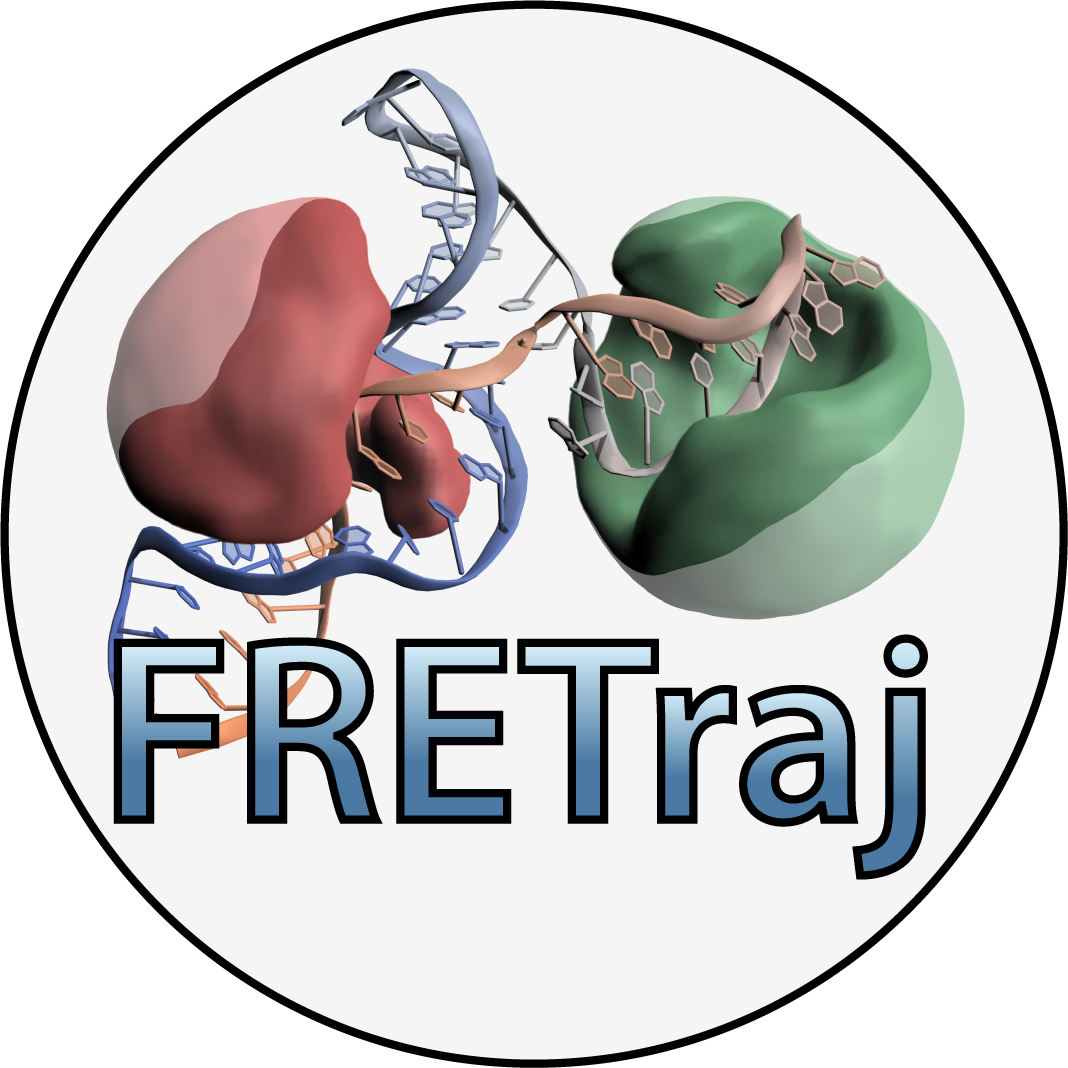The parameter files#
FRETraj uses two different json-formatted parameter files: one for ACV/FRET calculation and another to simulate photon bursts. Their general structure is outlined in the following:
ACV/FRET calculation#
{"Position":
{"<string defining the dye position>":
{"attach_id": int,
"linker_length": float,
"linker_width": float,
"dye_radius1": float,
"dye_radius2": float,
"dye_radius3": float},
},
"Distance": {"<string defining the fret pair>":
{"R0": float}
}
}
The parameters above are mandatory and need to be defined by the user. Other parameters have default values:
{"Position":
{"<string defining the dye position>":
{"cv_thickness": 0,
"cv_fraction": 0.5,
"simulation_type": "AV3",
"grid_spacing": 1.0,
"mol_selection": "all",
"state": 1,
"frame_mdtraj": 0,
"use_LabelLib": True}
},
"Distance": {"<string defining the fret pair>":
{"n_dist": 10E+6}
}
}
The parameters are described in more detail in the sections Calculating ACVs and making FRET predictions
Hint
The distance unit of FRETraj is Angstrom (MDTraj in contrast uses nanometers). The time unit is picosecond.
Note
If
simulation_type: "AV1"the dye is only defined by a single radiusdye_radius1.mol_selectiontakes a valid atom selection expression compatible with MDTraj
Finally, some parameters are solely used for visualization in PyMOL:
{"Position":
{"<string defining the dye position>":
{"contour_level_AV": 0,
"contour_level_CV": 0.7,
"b_factor": 100,
"gaussian_resolution": 2,
"grid_buffer": 2.0,
"transparent_AV": True}
}
}
Further details about the simulation settings are provided in the cloud and fret submodule descriptions.
Burst simulation#
The structure of the second parameter file is as follows:
{"dyes":
{"tauD": float,
"tauA": float,
"QD": float,
"QA": float,
"etaD":float,
"etaA":float
},
"fret":
{"R0": 54},
"species":
{"name": [string],
"unix_pattern_rkappa": [<regex-string>],
"probability": [float]
},
"bursts":
{"lower_limit": 15,
"upper_limit": 150,
"lambda": -2.3,
"averaging": "all"
}
}
The above key-values are mandatory. The main keys define photopyhsical parameters (dyes), the FRET pair (fret), identifiers and weights of individual subpopulations (species) and characteristics of the burst size distribution (bursts). The individual parameters are briefly described below:
dyestauD/tauA: fluorescence lifetime of the donor and acceptor dyeQD/QA: quantum yields of the donor and acceptor dyeetaD/etaA: detection efficiency of the donor and acceptor channel
fretR0: Förster radius in Angstrom
speciesname: list of names of the different subpopulationsunix_pattern_rkappalist of regular expressions identifying the R_kappa-files of the subspopulationsprobability: list of probabilities of the subpopulations
burstslower_limit/upper_limit: lower and upper treshold of the burst size distributionlambda: coefficient of the analytical burst size distribution (power law)averaging: method of averaging over the MD simulations, available options are:ensemble(the entire ensemble is present in a single burst),species(each burst only contains molecules of the same species) ortrajectory(only a one trajectory per burst).
Hint
The
averagingparameter becomes important if multiple trajectories are run with different starting conformations, which are not expected to exchange on the timescale of the simulation (e.g. cis/trans isomerization of prolines, see [6, 7]). If on the other hand, only a single trajectory is available all three settings should give the same results (althoughensemblemay run a bit faster than the other two).
Additional, optional parameters and their default values include:
{"dyes":
{dipole_angle_abs_em: 0},
"sampling":
{"nbursts": 2000,
"skipframesatstart": 0,
"skipframesatend": 1000,
"multiprocessing": True
},
"fret":
{"kappasquare": 0.6666
"gamma": True,
"quenching_radius" 1,
}
"species":
{"unix_pattern_don_coords": None,
"unix_pattern_acc_coords": None,
"n_trajectory_splits": None
},
"bursts":
{"burst_size_file": None,
"QY_correction": False,
}
}
Note
The fretraj.burst submodule can also be used to analyze MD simulations with all-atom dyes. Including the dyes explicitely in the simulations has the advantage that a transition dipole vector
can be defined. This allows to additionally simulate fluorescence anisotropy decays, which can be activated by setting compute_anisotropy=True in fretraj.burst.experiment().
dyesdipole_angle_abs_em: angle between the excitation and emission dipole in the absence of rotational diffusion (i.e. at time point 0; reduces the fundamental anisotropy \(r_0\); for all-atom dye simulations only)
sampling:nbursts: number of bursts to generateskipframesatstart/skipframesatend: number of frames (not time) to skip at the beginning and end of each trajectory when searching for excitation time pointsmultiprocessing: distribute workload on multiple cores
fretkappasquare: \(\kappa^2\) value for the givenR0(usually isotropic averaging, i.e. 2/3)gamma: to compare the simulation against a gamma-corrected FRET experiment set this parameter toTrue(default).quenching_radius: radius below which radiationless deactivation occurs due to contact quenching of the dyes
speciesunix_pattern_don_coords/unix_pattern_acc_coords: regular expression identifying the xyz-coordinates (xvg-files generated by GROMACSgmx traj) of the donor and acceptor dye (required for all-atom dye simulations)n_trajectory_splitssplit the trajectory into \(n\) parts (together withaveraging="trajectory"this simulates non-interconverting species which leads to broadening; usually this should be left at the default:None)
burstsburst_size_file: relative path to an experimental burst size distribution file containing two columns: burst sizes and their probabilities). If this setting is not specified, then an analytical power law distribution defined by the coefficientlambdais used.QY_correction: correct the number of donor and acceptor photons by their respective quantum yield when evaluating whether the burstsize is reached. Usually experimental bursts are identified based on uncorrected photon numbers, so this setting defaults toFalseExample for illustration
Let’s assume we collected 20 donor photons (with
QD=0.5) and 25 acceptor photons (withQA=0.75) and the size of this particular burst is 50. IfQY_correction=Falsethe total photon count is 20+25=45 photons, so the required burstsize is not reached yet. ifQY_correction=Truethe total photon count is (20/0.5 + 25/0.75 = 73) and so the burst is complete.
